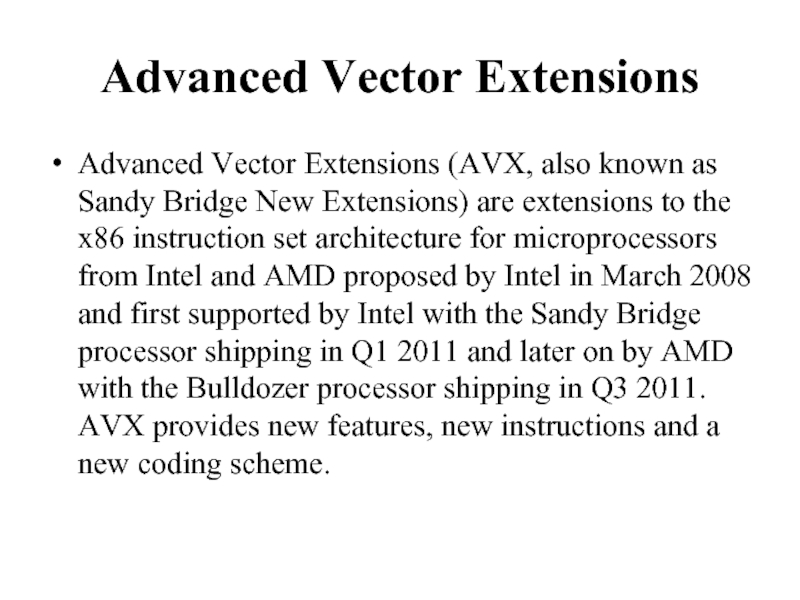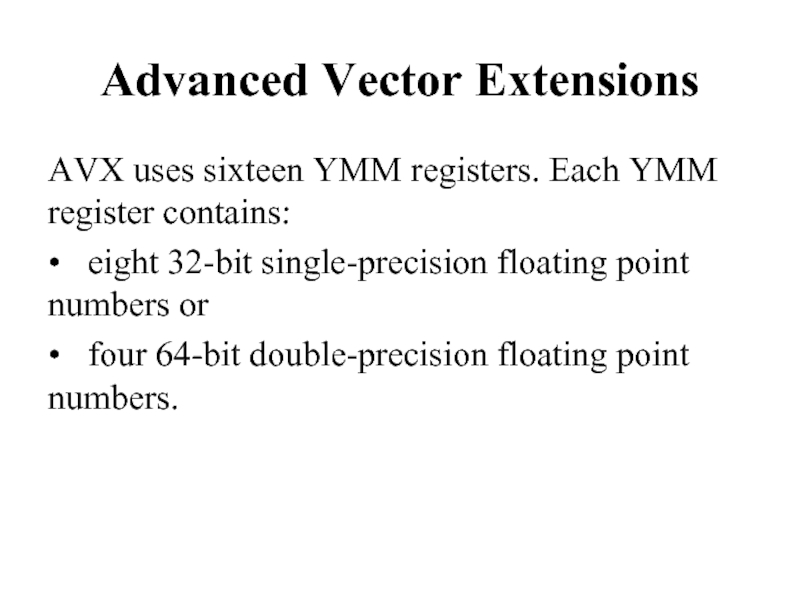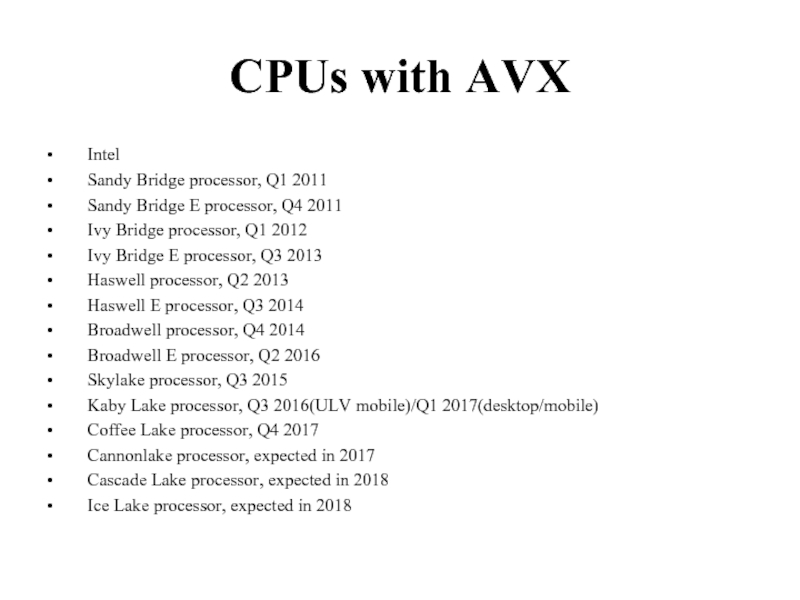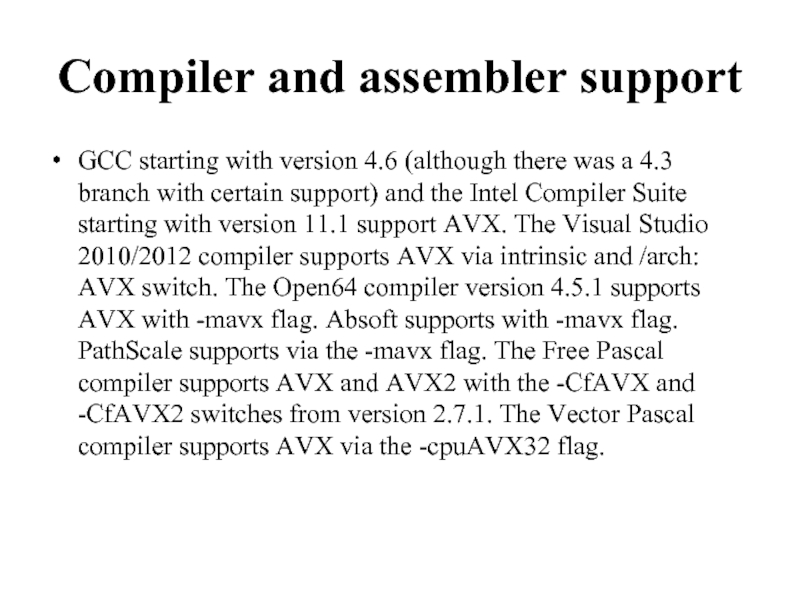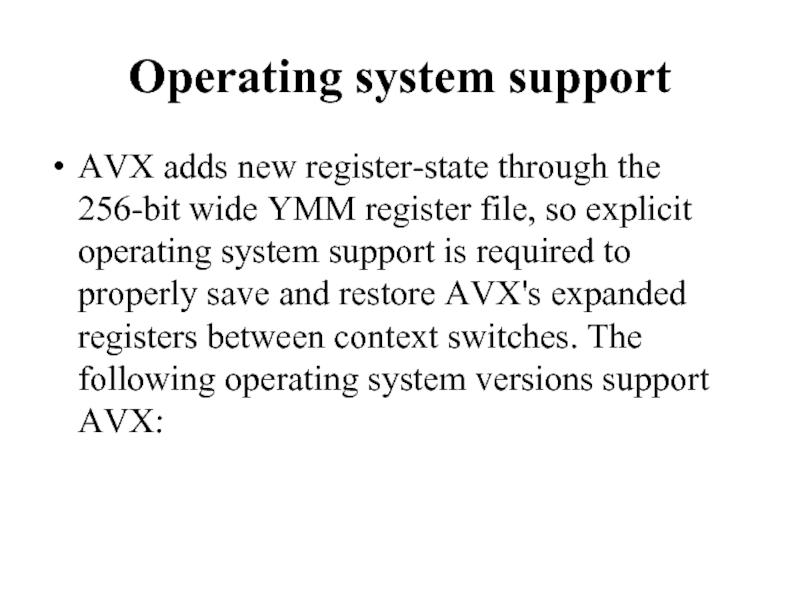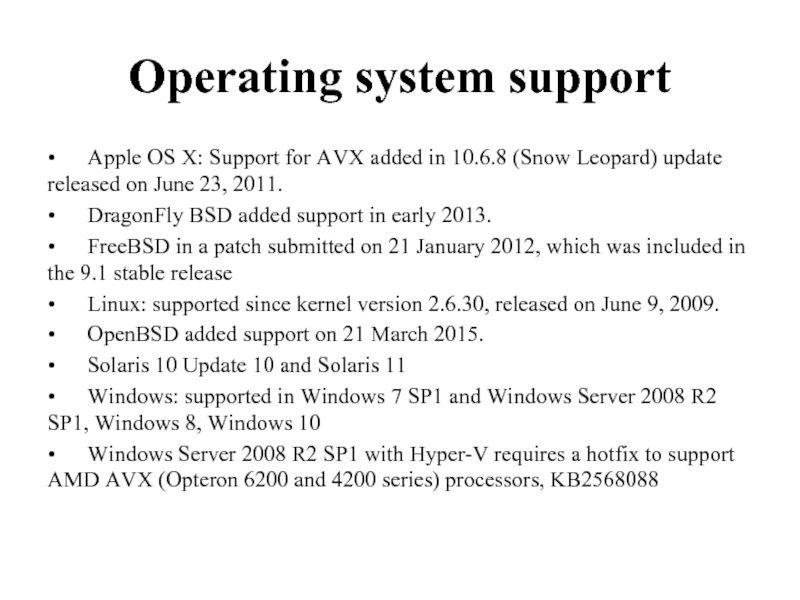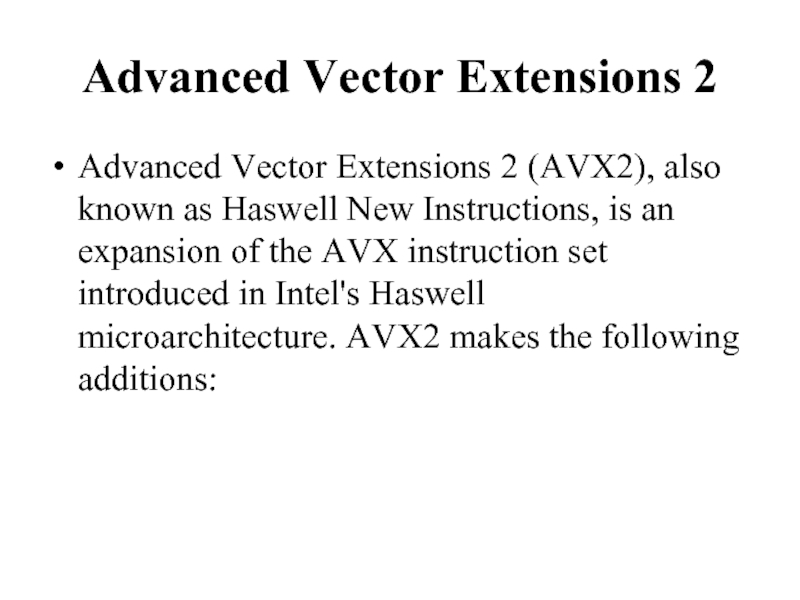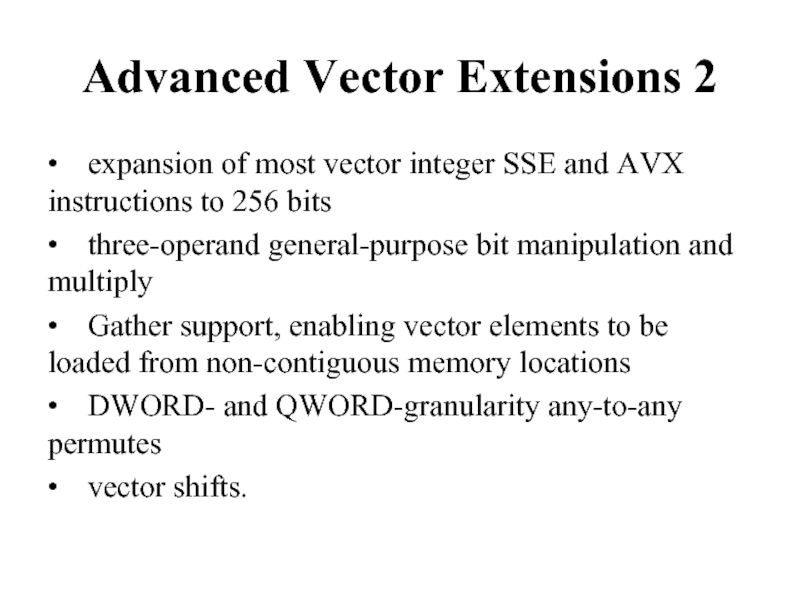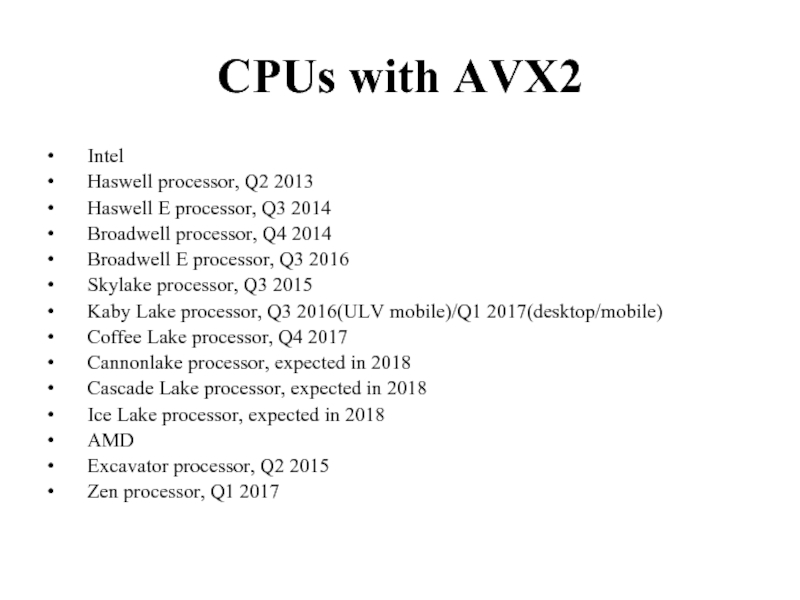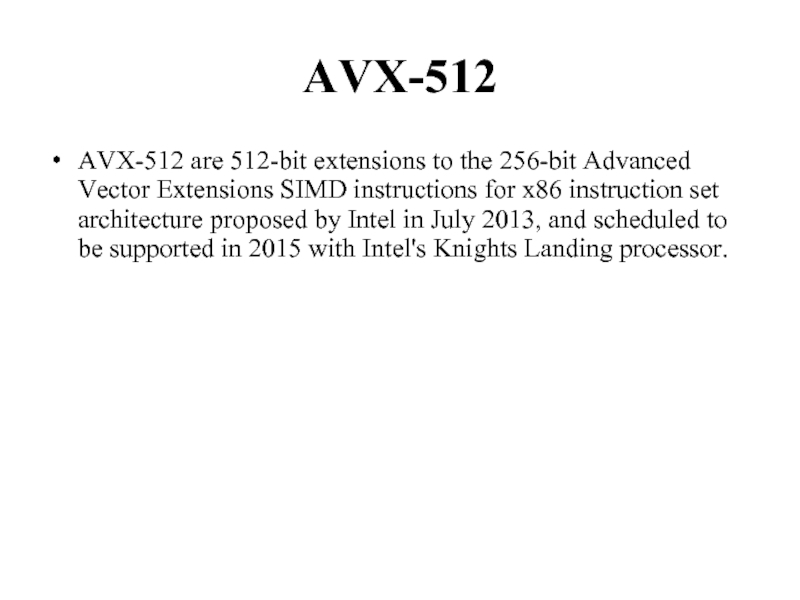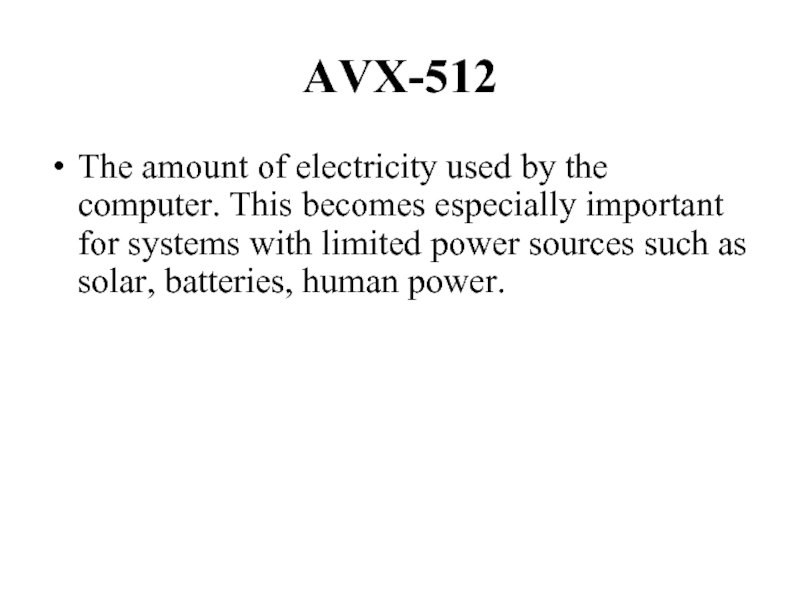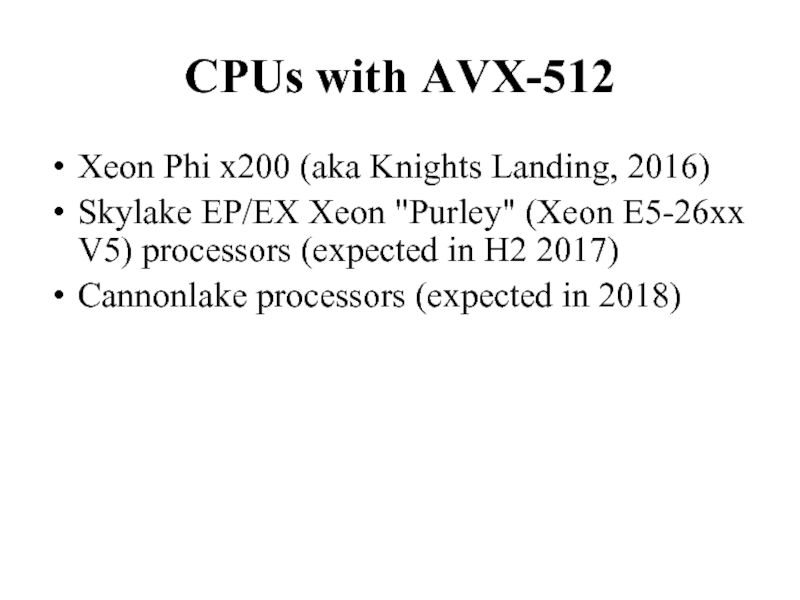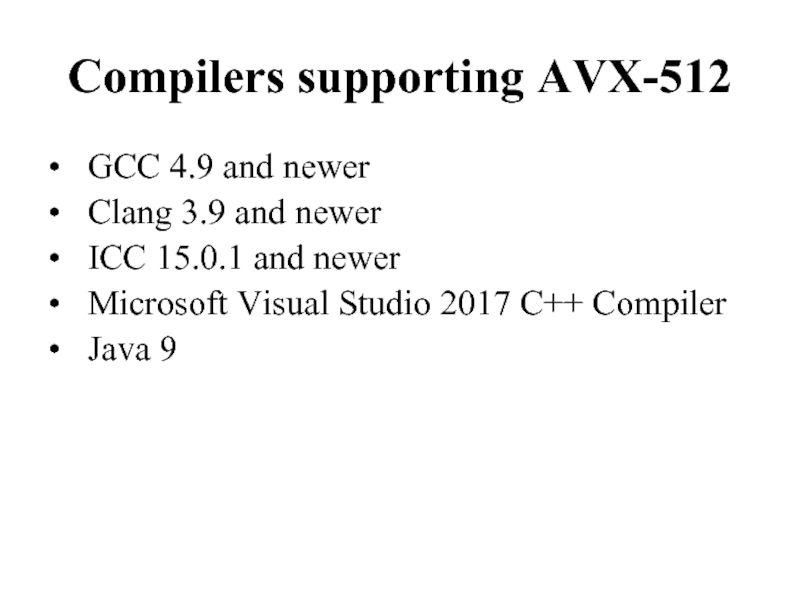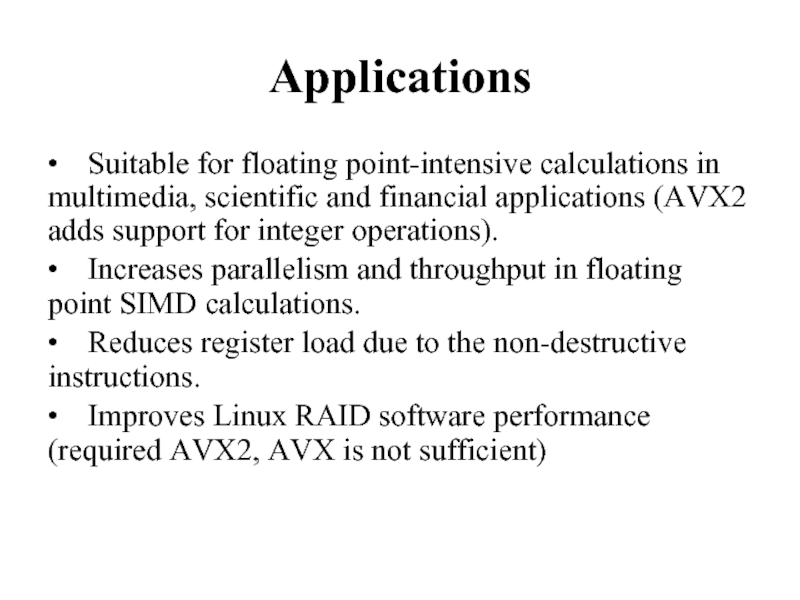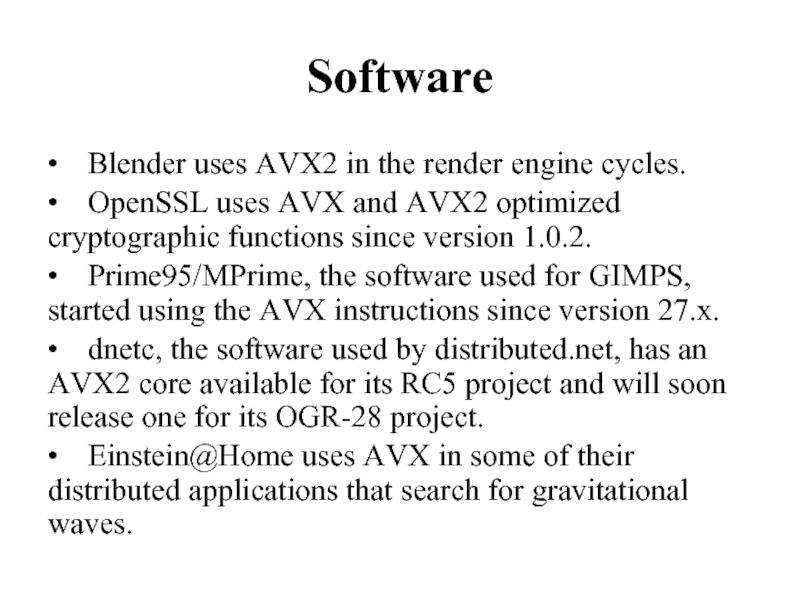- Главная
- Разное
- Дизайн
- Бизнес и предпринимательство
- Аналитика
- Образование
- Развлечения
- Красота и здоровье
- Финансы
- Государство
- Путешествия
- Спорт
- Недвижимость
- Армия
- Графика
- Культурология
- Еда и кулинария
- Лингвистика
- Английский язык
- Астрономия
- Алгебра
- Биология
- География
- Детские презентации
- Информатика
- История
- Литература
- Маркетинг
- Математика
- Медицина
- Менеджмент
- Музыка
- МХК
- Немецкий язык
- ОБЖ
- Обществознание
- Окружающий мир
- Педагогика
- Русский язык
- Технология
- Физика
- Философия
- Химия
- Шаблоны, картинки для презентаций
- Экология
- Экономика
- Юриспруденция
Advanced Vector Extensions (AVX) instruction set architecture презентация
Содержание
- 1. Advanced Vector Extensions (AVX) instruction set architecture
- 2. Advanced Vector Extensions Advanced Vector Extensions (AVX,
- 3. Advanced Vector Extensions AVX uses sixteen YMM
- 4. CPUs with AVX • Intel • Sandy Bridge processor,
- 5. Compiler and assembler support GCC starting with
- 6. Operating system support AVX adds new register-state
- 7. Operating system support • Apple OS X: Support
- 8. Advanced Vector Extensions 2 Advanced Vector Extensions
- 9. Advanced Vector Extensions 2 • expansion of most
- 10. CPUs with AVX2 • Intel • Haswell processor, Q2
- 11. AVX-512 AVX-512 are 512-bit extensions to the
- 12. AVX-512 The amount of electricity used by
- 13. CPUs with AVX-512 Xeon Phi x200 (aka
- 14. Compilers supporting AVX-512 • GCC 4.9 and newer
- 15. Applications • Suitable for floating point-intensive calculations in
- 16. Software • Blender uses AVX2 in the render
Слайд 2Advanced Vector Extensions
Advanced Vector Extensions (AVX, also known as Sandy Bridge
New Extensions) are extensions to the x86 instruction set architecture for microprocessors from Intel and AMD proposed by Intel in March 2008 and first supported by Intel with the Sandy Bridge processor shipping in Q1 2011 and later on by AMD with the Bulldozer processor shipping in Q3 2011. AVX provides new features, new instructions and a new coding scheme.
Слайд 3Advanced Vector Extensions
AVX uses sixteen YMM registers. Each YMM register contains:
• eight
32-bit single-precision floating point numbers or
• four 64-bit double-precision floating point numbers.
• four 64-bit double-precision floating point numbers.
Слайд 4CPUs with AVX
• Intel
• Sandy Bridge processor, Q1 2011
• Sandy Bridge E processor, Q4
2011
• Ivy Bridge processor, Q1 2012
• Ivy Bridge E processor, Q3 2013
• Haswell processor, Q2 2013
• Haswell E processor, Q3 2014
• Broadwell processor, Q4 2014
• Broadwell E processor, Q2 2016
• Skylake processor, Q3 2015
• Kaby Lake processor, Q3 2016(ULV mobile)/Q1 2017(desktop/mobile)
• Coffee Lake processor, Q4 2017
• Cannonlake processor, expected in 2017
• Cascade Lake processor, expected in 2018
• Ice Lake processor, expected in 2018
• Ivy Bridge processor, Q1 2012
• Ivy Bridge E processor, Q3 2013
• Haswell processor, Q2 2013
• Haswell E processor, Q3 2014
• Broadwell processor, Q4 2014
• Broadwell E processor, Q2 2016
• Skylake processor, Q3 2015
• Kaby Lake processor, Q3 2016(ULV mobile)/Q1 2017(desktop/mobile)
• Coffee Lake processor, Q4 2017
• Cannonlake processor, expected in 2017
• Cascade Lake processor, expected in 2018
• Ice Lake processor, expected in 2018
Слайд 5Compiler and assembler support
GCC starting with version 4.6 (although there was
a 4.3 branch with certain support) and the Intel Compiler Suite starting with version 11.1 support AVX. The Visual Studio 2010/2012 compiler supports AVX via intrinsic and /arch: AVX switch. The Open64 compiler version 4.5.1 supports AVX with -mavx flag. Absoft supports with -mavx flag. PathScale supports via the -mavx flag. The Free Pascal compiler supports AVX and AVX2 with the -CfAVX and -CfAVX2 switches from version 2.7.1. The Vector Pascal compiler supports AVX via the -cpuAVX32 flag.
Слайд 6Operating system support
AVX adds new register-state through the 256-bit wide YMM
register file, so explicit operating system support is required to properly save and restore AVX's expanded registers between context switches. The following operating system versions support AVX:
Слайд 7Operating system support
• Apple OS X: Support for AVX added in 10.6.8
(Snow Leopard) update released on June 23, 2011.
• DragonFly BSD added support in early 2013.
• FreeBSD in a patch submitted on 21 January 2012, which was included in the 9.1 stable release
• Linux: supported since kernel version 2.6.30, released on June 9, 2009.
• OpenBSD added support on 21 March 2015.
• Solaris 10 Update 10 and Solaris 11
• Windows: supported in Windows 7 SP1 and Windows Server 2008 R2 SP1, Windows 8, Windows 10
• Windows Server 2008 R2 SP1 with Hyper-V requires a hotfix to support AMD AVX (Opteron 6200 and 4200 series) processors, KB2568088
• DragonFly BSD added support in early 2013.
• FreeBSD in a patch submitted on 21 January 2012, which was included in the 9.1 stable release
• Linux: supported since kernel version 2.6.30, released on June 9, 2009.
• OpenBSD added support on 21 March 2015.
• Solaris 10 Update 10 and Solaris 11
• Windows: supported in Windows 7 SP1 and Windows Server 2008 R2 SP1, Windows 8, Windows 10
• Windows Server 2008 R2 SP1 with Hyper-V requires a hotfix to support AMD AVX (Opteron 6200 and 4200 series) processors, KB2568088
Слайд 8Advanced Vector Extensions 2
Advanced Vector Extensions 2 (AVX2), also known as
Haswell New Instructions, is an expansion of the AVX instruction set introduced in Intel's Haswell microarchitecture. AVX2 makes the following additions:
Слайд 9Advanced Vector Extensions 2
• expansion of most vector integer SSE and AVX
instructions to 256 bits
• three-operand general-purpose bit manipulation and multiply
• Gather support, enabling vector elements to be loaded from non-contiguous memory locations
• DWORD- and QWORD-granularity any-to-any permutes
• vector shifts.
• three-operand general-purpose bit manipulation and multiply
• Gather support, enabling vector elements to be loaded from non-contiguous memory locations
• DWORD- and QWORD-granularity any-to-any permutes
• vector shifts.
Слайд 10CPUs with AVX2
• Intel
• Haswell processor, Q2 2013
• Haswell E processor, Q3 2014
• Broadwell processor,
Q4 2014
• Broadwell E processor, Q3 2016
• Skylake processor, Q3 2015
• Kaby Lake processor, Q3 2016(ULV mobile)/Q1 2017(desktop/mobile)
• Coffee Lake processor, Q4 2017
• Cannonlake processor, expected in 2018
• Cascade Lake processor, expected in 2018
• Ice Lake processor, expected in 2018
• AMD
• Excavator processor, Q2 2015
• Zen processor, Q1 2017
• Broadwell E processor, Q3 2016
• Skylake processor, Q3 2015
• Kaby Lake processor, Q3 2016(ULV mobile)/Q1 2017(desktop/mobile)
• Coffee Lake processor, Q4 2017
• Cannonlake processor, expected in 2018
• Cascade Lake processor, expected in 2018
• Ice Lake processor, expected in 2018
• AMD
• Excavator processor, Q2 2015
• Zen processor, Q1 2017
Слайд 11AVX-512
AVX-512 are 512-bit extensions to the 256-bit Advanced Vector Extensions SIMD
instructions for x86 instruction set architecture proposed by Intel in July 2013, and scheduled to be supported in 2015 with Intel's Knights Landing processor.
Слайд 12AVX-512
The amount of electricity used by the computer. This becomes especially
important for systems with limited power sources such as solar, batteries, human power.
Слайд 13CPUs with AVX-512
Xeon Phi x200 (aka Knights Landing, 2016)
Skylake EP/EX Xeon
"Purley" (Xeon E5-26xx V5) processors (expected in H2 2017)
Cannonlake processors (expected in 2018)
Cannonlake processors (expected in 2018)
Слайд 14Compilers supporting AVX-512
• GCC 4.9 and newer
• Clang 3.9 and newer
• ICC 15.0.1 and
newer
• Microsoft Visual Studio 2017 C++ Compiler
• Java 9
• Microsoft Visual Studio 2017 C++ Compiler
• Java 9
Слайд 15Applications
• Suitable for floating point-intensive calculations in multimedia, scientific and financial applications
(AVX2 adds support for integer operations).
• Increases parallelism and throughput in floating point SIMD calculations.
• Reduces register load due to the non-destructive instructions.
• Improves Linux RAID software performance (required AVX2, AVX is not sufficient)
• Increases parallelism and throughput in floating point SIMD calculations.
• Reduces register load due to the non-destructive instructions.
• Improves Linux RAID software performance (required AVX2, AVX is not sufficient)
Слайд 16Software
• Blender uses AVX2 in the render engine cycles.
• OpenSSL uses AVX and
AVX2 optimized cryptographic functions since version 1.0.2.
• Prime95/MPrime, the software used for GIMPS, started using the AVX instructions since version 27.x.
• dnetc, the software used by distributed.net, has an AVX2 core available for its RC5 project and will soon release one for its OGR-28 project.
• Einstein@Home uses AVX in some of their distributed applications that search for gravitational waves.
• Prime95/MPrime, the software used for GIMPS, started using the AVX instructions since version 27.x.
• dnetc, the software used by distributed.net, has an AVX2 core available for its RC5 project and will soon release one for its OGR-28 project.
• Einstein@Home uses AVX in some of their distributed applications that search for gravitational waves.

